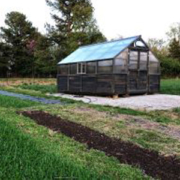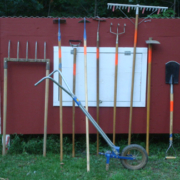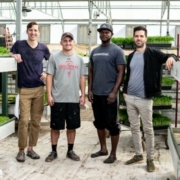Growing Vegetable Transplants in the Greenhouse
 Print This Post
Print This Post
By Luke Freeman, NCAT Horticulture Specialist
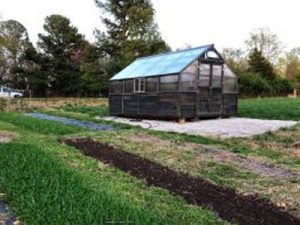 Earlier this spring, my wife and I got a 12×16 foot greenhouse for our small farm to use for starting vegetable and flower transplants for our garden. The greenhouse arrived just in time, before COVID-19 restrictions went into place in our state. We have been able to start our tomatoes, peppers, basil, zinnias, cosmos, and other garden transplants in the greenhouse and I wanted to share some of our techniques for growing quality plants at home or on a small farm.
Earlier this spring, my wife and I got a 12×16 foot greenhouse for our small farm to use for starting vegetable and flower transplants for our garden. The greenhouse arrived just in time, before COVID-19 restrictions went into place in our state. We have been able to start our tomatoes, peppers, basil, zinnias, cosmos, and other garden transplants in the greenhouse and I wanted to share some of our techniques for growing quality plants at home or on a small farm.
Essentials for Seedling Success
Many of you may be veteran seed-starters, or you may be starting seeds for the first time. But once you get those seeds to germinate, there are a few things you must provide them. Light is the most important factor because it seems to be the most limiting element for most home growers. If you have a greenhouse, light won’t be a problem, but if you are starting seeds indoors, you will need to provide supplemental lighting, which can take the form of fluorescent shop lights. Last year, before we had our greenhouse, we grew our transplants indoors on a rack with fluorescent shop lights and we had great success.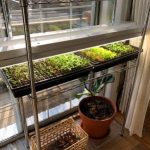
Keep an eye on the temperature for your seedlings. Most vegetable starts grow best at temperatures between 60 and 75°F, which is a bit lower than the ideal germination temperature (75 to90°F). If you used a heating source to encourage germination, make sure to lower the temperature after the seedlings have emerged. Solanaceous crops like tomatoes and peppers will still thrive will bottom-heat around 75 to 80°F for the first several weeks after germination. But for most seedlings, excessive temperatures will cause them to grow tall, spindly and weak – especially if there is insufficient light.
Water is another critical element, but this one is not very hard to provide. Most people tend to over-water their plants they are staring indoors, so be sure to let the media dry out before watering again. Plant roots need a mix of oxygen and water. If you keep the media water-logged, the plant roots will be deprived of oxygen and the plants will not thrive.
Plants also need nutrients. Depending on the type of potting media you started your seeds in, you may need to fertilize to ensure that your seedlings have sufficient nutrients. Most seed-starting potting mixes will be very low in nutrient values, so you will need to pot up into a growing mix with fertilizer or supplement with liquid fertilizer. You can learn more about finding or making the right potting mix in our ATTRA publication Potting Mixes for Certified Organic Production, which is available as a free download. Be sure to also watch the ATTRA video Potting Mix, where NCAT horticulture specialist Tammy Howard shares her recipe for potting mix from her cut-flower operation.
If you are growing in a mix that contains compost or a starter charge of nutrients, your plants may be set for several weeks. But be sure to look for nutrient deficiency symptoms such as yellowing leaves (nitrogen deficiency) or purpling leaves (phosphorus deficiency) and fertilize when you see these symptoms appear. Over-watering can also lead to similar symptoms, so be sure that you are not keeping your potting media saturated.
If you need to fertilize your starts, I recommend a liquid fish fertilizer that you can dilute in water and apply with a watering can. Most liquid fish products have a nutrient value of around 3% nitrogen, 1% phosphate, and 1% potash, which is fairly balanced. Also, most liquid fish fertilizers are allowed in organic production.
Growing Healthy Vegetable Transplants
We like to start our seeds in 200-plug trays, which means we have to “bump up” or “pot up” into larger containers soon after the seedlings develop their first set of true leaves. This past weekend, I spent time in the greenhouse potting up our tomato seedlings, which were in desperate need of more room to grow. I potted up into 3-inch pots and 606 inserts (6-packs), which will provide enough soil for the seedlings until it is time to plant them out (around May 1 for us here in Northwest Arkansas). In total, our tomatoes will spend about six weeks in the greenhouse before they are planted out.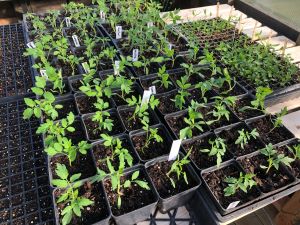
Successful plant care in the greenhouse or at home comes down to providing your seedlings with the right environment – light, temperature, water, nutrients, and enough room for their roots to stretch out and grow. If you are attentive to the needs of your seedlings, you will find them thriving and growing into healthy transplants.
Photos: Luke Freeman, NCAT
This publication is produced by the National Center for Appropriate Technology through the ATTRA Sustainable Agriculture program, under a cooperative agreement with USDA Rural Development. ATTRA.NCAT.ORG.

